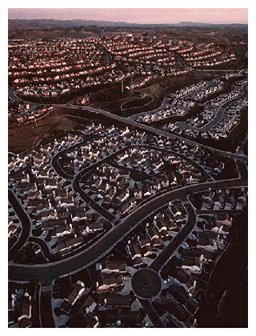
Suburban Sprawl
Source:
www.infed.org/ community/community.htm
Urban growth boundaries (UGB's) are part of an increasing emphasis on growth management programs that are intent on slowing and/or stopping sprawl. Implemented in multiple cities, UGB's have undergone much scrutiny from citizens and planners to determine whether or not they are accomplishing their outlined goals. While the primary reasons for creating a UGB are to curb suburban sprawl and to protect farmland and open space, planners, economists, and community members are recognizing that boundaries have both positive and negative effects. UGB's have not typically taken the role of driving economic development in an urban region. Many critics say that UGB's in fact, do more harm than good to some communities. It is evident however, that UGB's are affecting development processes, from gentrification, to downtown development, to housing prices, labor markets, and neighborhood character. In this entry I explore some of these varying effects of UGB's on economic development programs. I also plan to show where the connection between these two planning concepts lies. A successful smart growth and/or comprehensive plan should be created to utilize and combine the best practices of both UGB's and economic development programs.
 |
| Suburban Sprawl |
According to the EPA, an urban growth boundary is “a mapped line that separates land on which development will be concentrated from land on which development will be discouraged or prohibited.” The goals of UGB's include limiting development to a specific region to increase the density in urban areas, as well as protecting and preserving open spaces and farmland outside city boundaries. A UGB is a growth management mechanism and is typically associated with curbing sprawl in suburbs outside urban areas; thus a UGB is often responsible for separating urban from more rural areas. A typical UGB is designed for a 20 year period, but they can be expanded to include more area and are usually evaluated regularly to accommodate growth. A UGB is a land use program, and often requires zoning changes. The key to UGB's and other smart growth programs is managing growth without sacrificing affordable housing or limiting economic development (Danielsen 1999, Maryland 1992, Byrd 1999).
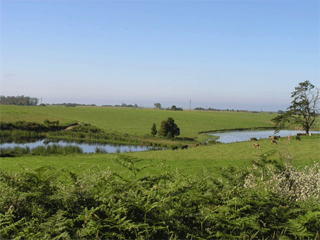 |
Farmland |
The most notable implementation of a UGB is Portland , Oregon , which created an urban growth boundary in 1979 after the state passed the 1973 Land Conservation and Development Act requiring all cities in the state to plan for them. Other notable cities that have adopted UGB's include, Seattle , Washington , Boulder , Colorado , Lancaster County , Pennsylvania and Minneapolis/St. Paul, Minnesota . Internationally, London , Copenhagen and Vancouver also use UGB's (Byrd 1999, Maryland 1992).
Most advocates of smart growth purport that their practices will promote economic development. Decentralization of economic activity has plagued cities of late, draining their human capital into the surrounding suburbs. Urban growth boundaries arose as a way to combat this problem. By creating “cities without suburbs,” urban areas are able to better seize internal opportunities to develop underutilized land (Nelson 2004). UGB's can hence be a powerful tool for central-city revitalization. UGB's encourage infill development. By preventing development outside the urban area, industry, retail and housing is forced to be built on vacated or underused parcels within the boundary. This restriction creates much higher density living in urban areas, a trend that many planners see as a best practice. Furthermore, the infill is increasingly mixed-use, combining commercial, industrial, and residential uses in one development to better utilize scarce and valuable land (Danielsen 1999, Maryland 1992).
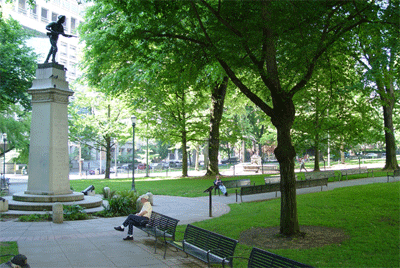 |
Park in Portland |
The benefits of higher density, mixed use living have been articulated by many planners. This development reduces automobile dependence and, when coupled with a pedestrian-friendly layout or mass-transit system, reduces pollution and traffic. Mixed-use areas draw many types of people to an easily accessible area, which in turn creates a thriving neighborhood or area. Planners also contend that UGB's encourage the provision affordable housing for low and middle class citizens to bring people back into the inner city (Danielsen 1999). These types of improvements for a city, creating a more “hip” urban atmosphere often draw a population of skilled professional youth who further revitalize and stimulate the economy. Humanistic thinkers have even gone so far as to argue that UGB's bring about a rise in the entire quality of life of an area. By creating exciting urban lifestyles, and protecting outer open space, the people, future generations, and the environment all stand to gain (Byrd 1999).
 |
Portland Night Skyline |
The situation in Portland , Oregon is a useful example of UGB success. The city cites an unprecedented growth in manufacturing, which declined in the US overall between 1990 and 2000. This was a result of growth in the high tech and biomedical industries that took place in Portland , giving it the name “ Silicon Forest .” Citing an influx on almost 400,000 residents in the last 10 years, the city has lured a population of highly educated, high-income professionals which is in turn bringing retailers (Kirk 2004).
Mixed–use projects and transit-oriented development (TOD) have revitalized the downtown regions by building up, not out. The new Bridgeport Village and Tanasbourne Town Center will add millions of square feet of office, shops, restaurants and entertainment venues. More development is planned for the river and waterfront districts. Even grocery stores have capitalized on new development patterns. Safeway has chosen Portland as the first site for its new vertically oriented urban store featuring apartments above and parking below the store. The Brewery Blocks project even involves the adaptive reuse of historical structures (Kirk 2004).
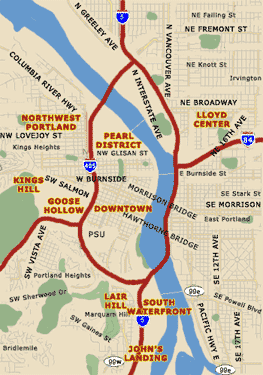 |
Portland Map |
The boundary has also created high land values and smaller land parcels which allow for ‘selective development.' Big box retailers have been unable to dominate the Portland market because they cannot assemble large tracts of land. New emphasis has been places on luring high profile investors to increase the quality of retail offered in such a ‘starved market.' Furthermore, unemployment at the end of 2004 was 7.8 percent, down form 9 percent earlier in the decade. The central city area has retained 42 percent of newly created employment. Retail vacancy rates dropped to 6.2 percent in 2004 from 7 percent at the start of the year. Rents and property values have continued to rise. This data supports the idea that Portland has created a successful urban region (Kirk 2004). The UGB in this light seems to have sparked a vibrant downtown economy rich with industry, citizens, and retail.
Conversely however, the so-called positive results of UGB's often have very negative consequences on the overall development of an area, tending sometimes to slow growth. The purported rise in housing prices has been a highly contentious issue. The dramatic increase in housing prices following the implementation of a UGB can be attributed to two factors. The first is an increased demand for inner city housing, especially low-income housing, due to the inability of growth to occur outside the boundary. Furthermore, due to land scarcity, land values rise sharply for both vacant and developed properties. These factors create an affordable housing crisis which has the effect of excluding many citizens from a thriving urban environment. Higher prices and disjunct land pieces may also discourage or inhibit crucial industrial development in an area (Howe).
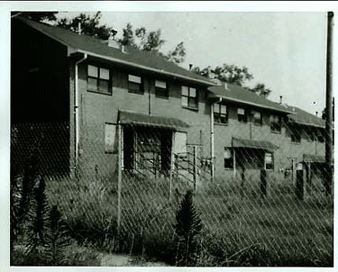 |
Dilapidated Housing Source: http://www.biblechurch.org/mission/durham.html |
Portland 's data confirms these trends. The price of a single family home rose over 50% from $104,743 in 1990 to $160,217 in 2000, creating some of the most unaffordable housing in the US . The overall increase in home values was 142 percent between 1970 and 2000. Fair market rent remained only at average rates, as did rate of homeownership. Homeownership rates were also significantly lower (20% lower) for minority residents. Furthermore, household income only grew 31 percent between 1969 to 1999, far outrun by housing values (Howe).
Population and labor trends are affected by this housing market. While drawing young professionals, UGB's seem to be excluding lower-income individuals. The city has significant pockets of poverty and a low percent of the population has completed high school. There was also a significantly high unemployment rate of 7.8 percent (Mayer). While not always apparent, these trends have significant economic impacts. The exclusion of various groups has divided the city, creating a lack of equity. On the aggregate, Portland may seem to be improving, but isolated neighborhoods are bearing the burden of others prosperity through inflated housing prices and scarce jobs. Is that really good economic development?
Instinctively, citizens are quick to reject higher density housing environments. Suburbanites who are used to large yards and lots tend to fear loss of property value and negative urban externalities such as noise, traffic, pollution, and crime. Concerned with quality of life, dense urban areas often suggest an unfamiliar and hostile character. (Danielsen 1999, Maryland 1992). Another crucial issue is industrial land development. Some economic developers are concerned that there is an insufficient amount of land to accommodate large, capital intensive firms, an investment that would increase employment and strengthen public revenue. All the above issues stem from the distorted market forces imposed by UGB's. While not in all cases completelying inhibiting economic development, UGB's are limiting the who and where of industry and human-capital development, mostly to the disadvantage of urban areas.
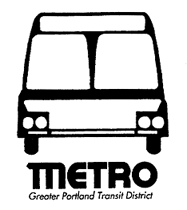 |
Metro Logo |
Urban growth boundaries by themselves are not recognized as a necessarily effective means of promoting economic development. Portland 's challenges as a result of UGB implementation support this hypothesis. Although UGB's influence growth and land use issues, their effects on economic development are secondary and sometimes deleterious. They may limit or eliminate the possibility of industry and affordable housing. It is also clear, from examples like Portland, that UGB's and economic development programs can be implemented together to catalyze urban renewal. As complementary and co-existent practices, specifically tailored economic development initiatives will enhance the areas that UGB's fail to address (Lang 1997).
The Metropolitan Service District of the Portland region is a prime example of this budding partnership. The Metro is the only elected regional body in the United States with authority to implement planning projects. This cooperative regional approach is better suited to mesh larger regional goals with specific area development. Portland thus has been rather progressive in addressing affordable housing and industry development issues in coordination with UGB goals. Programs like mandated fair-share housing and the expansion of the UGB have given more flexibility to the planning scheme and "built equity in the urban design" while not hindering economic development (Lang 1997). While the Portland urban growth boundary is considered a qualified success, there are many other cities and UGB's with economic development lessons to be learned.
Sources
Byrd, Robert. “Urban growth boundaries: A humanistic success story.” The Humanist. Buffalo: Jul/Aug 1999. Vol. 59, Iss. 4; pg. 30.
Chapman, Nancy and Hollie Lund. “Housing Density and Livability in Portland.” From The Portland Edge: Challenges and Successes in Growing Communities. Ed. by Connie P. Ozawa. Island Press. Portland State University, 2004, pp. 206-229.
Danielsen, Karen A., Robert E. Lang, & William Fulton. “What does smart growth mean for housing?” Housing Facts and Findings. Fall 1999, Vol. 1 Iss. 3. From Fannie Mae Foundation. http://www.fanniemaefoundation.org/programs/hff/v1i3-smart_growth.shtml
Howe, Deborah. “The Reality of Portland's Housing Markets.” From The Portland Edge: Challenges and Successes in Growing Communities. Ed. by Connie P. Ozawa. Island Press. Portland State University, 2004, pp. 184-205.
Kirk, Patricia L. “ Portland 's Progress.” Retail Traffic. May 2004.
Lang, Robert E. and Steven P. Hornburg. “Planning Portland Style: Pitfalls and Possibilities.” Housing Policy Debate Vol. 8, Iss. 1. Fannie Mae Foundation 1997.
Mayer, Heike and John Provo. “The Portland Edge in Context.” From The Portland Edge: Challenges and Successes in Growing Communities. Ed. by Connie P. Ozawa. Island Press. Portland State University , 2004, pp. 9-34.
Nelson, Arthur C., Raymond J. Burby, Edward Feser, Casey J. Dawkins, et al. “Urban Containment and Central-City Revitalization.” Journal of the American Planning Association . Autumn 2004, Vol. 70, pg. 411.
Phillips, Justin and Evan Goodstein. “Growth management and housing prices: The case of Portland, Oregon.” Contemporary Economic Policy . Huntington Beach : Jul 2000. Vol. 18, Iss. 3; pg. 334.
“Urban Growth Boundaries.” From Managing Maryland's Growth: Models and Guidelines . The Maryland Economic Growth, Resource Protection, and Planning Act of 1992. The Maryland Office of Planning.